Brighter beacons: Up close with Qualcomm's Gimbal for Apple Stores
With Gimbal, Qualcomm has a device that breaks quite a few molds. Open source, secure, and conceptually cool, Gimbal has the ability to actually make a difference in your day-to-day life. If you're one to shop at an Apple Store, chances are you already know just how sublimely smooth the Gimbal experience can be. We sat down with Kevin Hunter, Qualcomm's Senior Director of Product Management for Retail Solutions, to find out just how Gimbal makes it happen, both for retailers and consumers.
Gimbal is as simple as it is significant. With the small Bluetooth Low Energy (BLE) device(s), a retailer can push information to your smartphone or other connected device. Gimbal uses your proximity to push the right information, so you're more likely to get data that matters to you at that moment, in real time. This is especially handy for retailers with large, diverse shopping environments — but not limited to them. In being an iBeacon certified platform, Gimbal is already in one of the more popular shopping destinations — which just happens to be pretty small.
"The interest is just extremely overwhelming" said Hunter when prompted about the overall response Qualcomm is seeing to Gimbal. Though he would tell us Gimbal is being tested by several retailers, and wasn't at liberty to discuss who was involved just yet, he did confirm one sneaking suspicion we've had. When we asked whether it was Gimbal that was powering the Apple Store's iBeacon experience, the answer was a welcome one — but not surprising.
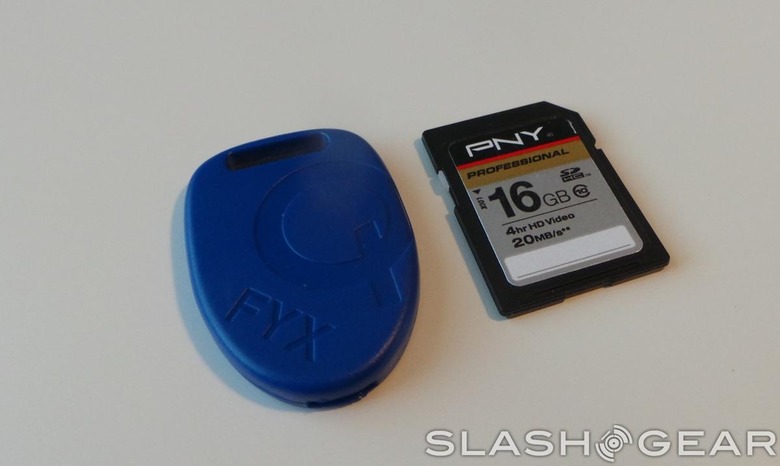
Hunter was able to confirm to us that it's Gimbal powering the Apple Store experience with regard to iBeacon. By going into an Apple Store and opening the Apple Store app, you may get push notifications while shopping in the store, especially near the accessories wall. With an iPhone and accompanying app, we were able to have one of the more unique shopping experiences we've ever had — powered by Gimbal.
Needing (wanting, really — I confuse the two a lot) a case for my MacBook Pro, I headed down to the Apple Store. I went over to the accessories wall where the cases were, and opened the Apple Store app. Without my having to do anything, a screen popped up, offering help when an employee wasn't available. A built-in barcode scanner feature already in the app let me scan the object of my desire, bringing up any info I may want, as well as the option to purchase.
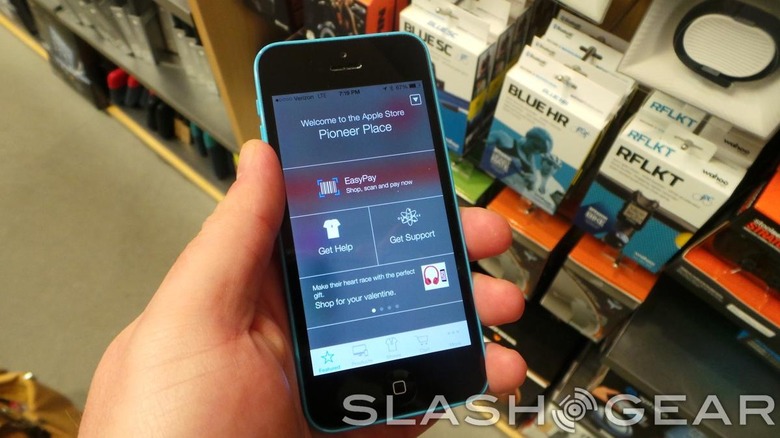
Though I had to jump through some hoops, like confirming the security code on the back of my card, the transaction went through seamlessly. A receipt was emailed to me, and I paid with the card I had on file with Apple. As I made my way out of the store, case tucked neatly under my arm, I expected that moment from the movies where the anti-hero almost gets away with it. Here I was, having not spoken to a soul in the store, walking out with merchandise. I actually made it out, too — and even got a wave from a nice Apple Store employee as I left.
It was a fleeting experience, but made me wonder: what if this were everywhere? Even without wanting to make a purchase, I was able to get info on other accessories. Gimbal, in tracking my proximity to it (tucked neatly away somewhere in the store) knew I was at the accessories wall. From there, it offered up a page within the Apple Store app, and allowed me to get the info I wanted. Reviews, features, and anything else I wanted to know about any item on that wall was available. Gimbal provided the awareness, and Apple provided the info.
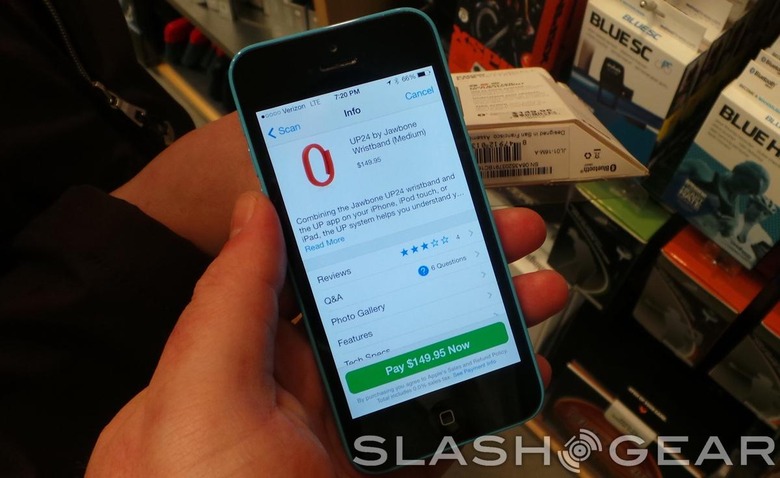
One concern I had on the way home was the safety of all this. Personal and payment information is stored somewhere, but we don't have to worry about that with Gimbal. The devices only feed location info, leaving the rest up to an app. Things like payment credentials and other personal info is all done away from Gimbal. Hunter tells us Qualcomm also has security and privacy implemented form the ground up, and anyone who wants to use Gimbal must adhere to their policies: users must be allowed to opt-in, there must be transparent value exchange (for instance, anyone asking for your location must be upfront about why they want to know where you are), and we as users have to be given a way to manage our info. Though Gimbal doesn't provide any kind of way to hold or cobble data together, it does provide the back-end solution for doing so, making it a link in the chain. Thankfully, it's a secure one that has lasting effects throughout the experience.
There was also the question of how this would affect us, as customers and people, day to day. The Apple Store thing is unique, but a trip there is unlikely to happen daily. "Inside of Qualcomm, we have a cafe, Perks cafe" says Hunter. "We have proximity payments set up. The point of sale has been enabled to understand the beacon. As I get close to it, my picture shows up. So, as I'm in the store, my picture shows up in one queue so they know I'm there. As I get closer, I'm moved to the 'in line' queue, and the higher priority my picture is in the system. At that point they're using signal strength to find out who's in the store versus who's in line, all with the same beacon."
Hunter goes on to describe how the system may know his preference, and by having his picture pop up at the point of sale terminal, the cashier or barista can greet him by name, ask if he wants his usual drink, and get him on his way. Like the Apple Store, his payment info can be stored in an app, so all he has to do is show up and grab some coffee; make nice with the baristas, and out the door he goes.
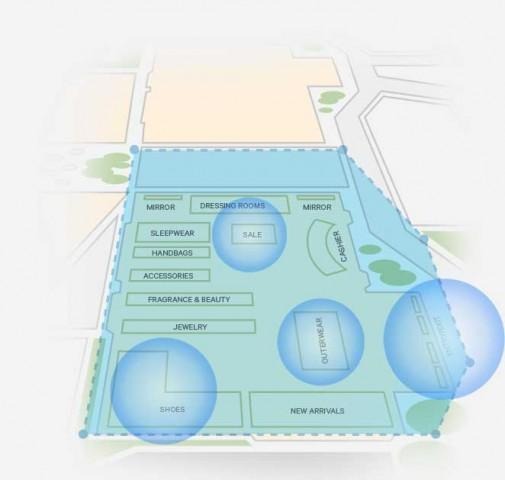
The real question is how. Imagining a signal being pulsed out from the device is easy to get, but how does Gimbal handle a non-radial environment? With an advanced geo-fencing system, Gimbal can actually allow retailers or other managers to push the right info to the right areas, which can be defined in their system. Coupled with macro and micro location awareness (which Hunter described in use at the Qualcomm cafe, above), Gimbal's possibilities are nearly endless. Gimbal would allow managers to know where you are, and push information to you as you navigated through the store. If you're in the shoe section of a department store, you may get info on a department-wide sale. Move over to an area with a particular brand, and there just might be an additional discount or new item highlighted.
The use-case scenarios we can run through for Gimbal are nearly endless. At just about every point in life, you want particular information at a certain time. Gimbal provides a solution for that. While the experience will vary from one location to the next, depending on who uses the devices and their particular platform, Gimbal's functionality remains mind-boggling. Though Apple won't be the last to use Gimbal in their retail environment, they do provide a blueprint for success. No obnoxious notifications, and the app must be open before we see anything. Checkout was easy, even if I did feel like a thief who paid first.
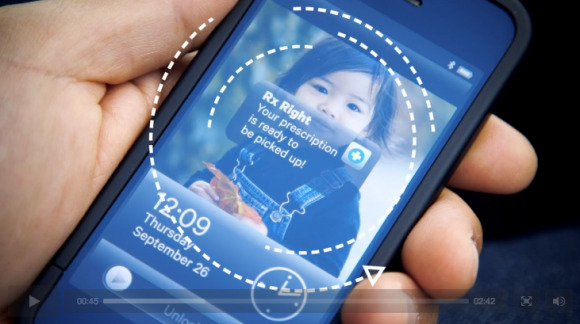
Devices like Gimbal could be the next frontier, really. Getting back to the coffee shop scenario, there would be nothing stopping the store from creating a service by which you walk in, with your "usual" going straight to the barista, leaving you to pay via the app. You know what you want, they know what you want, and you don't have to run-through the verbose exercise of ordering coffee or fumbling to get your card out. You're dangerously under-caffeinated, and who wants to have a conversation at that point anyway, right?
There is also nothing saying Gimbal has to be a retail solution, either. Hunter tells us they are seeing a huge amount of interest from venues like museums, and larger ones where you might go see a concert. Qualcomm's work with The Miami Dolphins shows why the interest is there, and more importantly, how it benefits us all.
Regardless of how one would choose to create an environment to use the functionality, one thing is certain — Qualcomm is convinced it'll be Gimbal breaking micro-location-based services into the mainstream. "We're providing that connection, the digital and physical bridge. From there, the services can do whatever they want. They can build the right experiences on top of the platform for their customers or employee base" said Hunter. Endless possibilities, all created by a little device pushing info and discovering your location.
